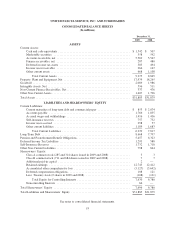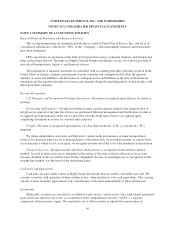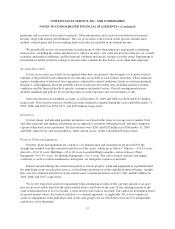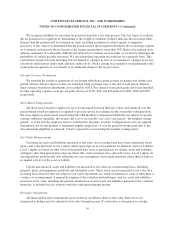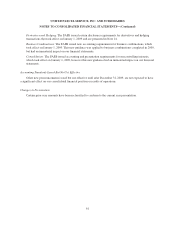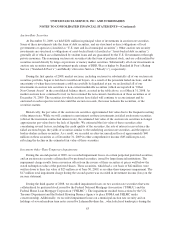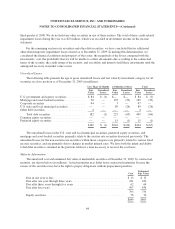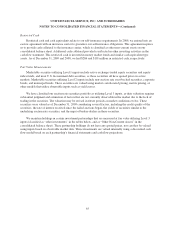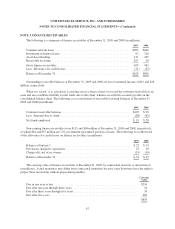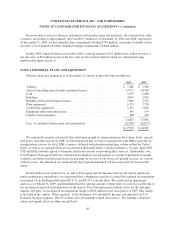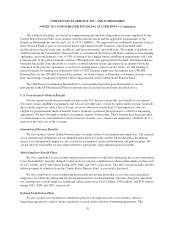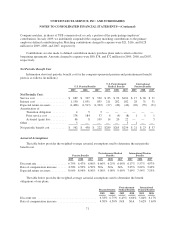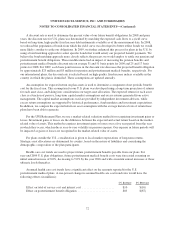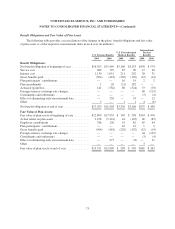UPS 2009 Annual Report Download - page 75
Download and view the complete annual report
Please find page 75 of the 2009 UPS annual report below. You can navigate through the pages in the report by either clicking on the pages listed below, or by using the keyword search tool below to find specific information within the annual report.UNITED PARCEL SERVICE, INC. AND SUBSIDIARIES
NOTES TO CONSOLIDATED FINANCIAL STATEMENTS—(Continued)
Auction Rate Securities
At December 31, 2009, we held $281 million in principal value of investments in auction rate securities.
Some of these investments take the form of debt securities, and are structured as direct obligations of local
governments or agencies (classified as “U.S. state and local municipal securities”). Other auction rate security
investments are structured as obligations of asset-backed trusts (classified as “Asset-backed debt securities”),
generally all of which are collateralized by student loans and are guaranteed by the U.S. Government or through
private insurance. The remaining auction rate securities take the form of preferred stock, and are collateralized by
securities issued directly by large corporations or money market securities. Substantially all of our investments in
auction rate securities maintain investment-grade ratings of BBB / Baa or higher by Standard & Poor’s Rating
Service (“Standard & Poor’s”) and Moody’s Investors Service (“Moody’s”), respectively.
During the first quarter of 2008, market auctions, including auctions for substantially all of our auction rate
securities portfolio, began to fail due to insufficient buyers. As a result of the persistent failed auctions, and the
uncertainty of when these investments could successfully be liquidated at par, we reclassified all of our
investments in auction rate securities to non-current marketable securities (which are reported in “Other
Non-Current Assets” in the consolidated balance sheet), as noted in the table above, as of March 31, 2008. As
market auctions have continued to fail, we have retained the non-current classification of these securities as of
December 31, 2009. The securities for which auctions have failed will continue to accrue interest and be
auctioned at each respective reset date until the auction succeeds, the issuer redeems the securities, or the
securities mature.
Historically, the par value of the auction rate securities approximated fair value due to the frequent resetting
of the interest rate. While we will continue to earn interest on these investments in failed auction rate securities
(often at the maximum contractual interest rate), the estimated fair value of the auction rate securities no longer
approximates par value due to the lack of liquidity. We estimated the fair value of these securities after
considering several factors, including the credit quality of the securities, the rate of interest received since the
failed auctions began, the yields of securities similar to the underlying auction rate securities, and the input of
broker-dealers in these securities. As a result, we recorded an after-tax unrealized loss of approximately $40
million on these securities as of December 31, 2009 in other comprehensive income ($65 million pre-tax),
reflecting the decline in the estimated fair value of these securities.
Investment Other-Than-Temporary Impairments
During the second quarter of 2009, we recorded impairment losses on certain perpetual preferred securities,
and an auction rate security collateralized by preferred securities, issued by large financial institutions. The
impairment charge results from conversion offers from the issuers of these securities at prices well below the
stated redemption value of the preferred shares. These securities, which had a cost basis of $42 million, were
written down to their fair value of $25 million as of June 30, 2009, as an other-than-temporary impairment. The
$17 million total impairment charge during the second quarter was recorded in investment income (loss) on the
income statement.
During the third quarter of 2008, we recorded impairment losses on two auction rate securities that were
collateralized by preferred stock issued by the Federal National Mortgage Association (“FNMA”) and the
Federal Home Loan Mortgage Corporation (“FHLMC”). The impairment resulted from actions by the U.S.
Treasury Department and the Federal Housing Finance Agency to place FNMA and FHLMC under
conservatorship. Additionally, we recorded impairment losses on a municipal auction rate security and on
holdings of several medium term notes issued by Lehman Brothers Inc., which declared bankruptcy during the
63


